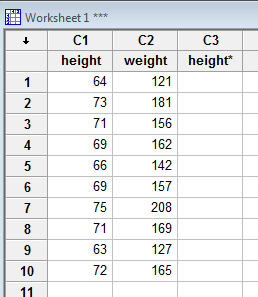


In this example, you may be most interested in obtaining the component scores (which are variables that are added to your data set) and/or to look at the dimensionality of the data.

You might use principal components analysis to reduce your 12 measures to a few principal components. When to use principal component analysis in Excel? You can then use the output to determine how many components explain most of the variation in the original variables. If you do not specify a number, Minitab calculates the maximum number of components, which equals the number of variables.
#Minitab calculator free
#Minitab calculator how to
#Minitab calculator code
› Legends Of Learning Enter Teacher Code.› Virgil I Grissom Elementary School Old Bridge.Current Employment Statistics from the Bureau of L.Lecture 6 - Ch 8b - Confidence Interval for the Me.Lecture 6 - Ch 8c - Determining Sample Size.Lecture 6 - Ch 9b - One-Tail Hypothesis Testing.Graphing the Normal Distribution Curve with Excel.Hypothesis Testing - Critical Value Approach - 6 S.Hypothesis Testing - p-Value Approach - 5 Step Met.Lecture 7 - Using Minitab to Calculate Hypothesis.Lecture 7 - Assumptions in the Method of Least Squ.Lecture 7 - Coefficient of Determination.Using the DePaul Online Library for Research.Lecture 8 - Residual Analysis - Definition.Lecture 8 - Residual Analysis - Checking Linearity.Since the p-value is larger than α we do not reject H 0. We compare t 0.025,26 to the t-score of the sample mean, which Minitab calculated for us as -0.23, and find that the t-score of the sample mean is between the critical values and therefore we do not reject H 0.įor the p-value approach, we compare the p-value that Minitab calculated as 0.821 and compare that to the level of significance, &alpha, which in our case is 0.10. 26 is n-1, the degrees of freedom for this test. 0.025 is α/2, which we use with this two-tail test. We need to do that ourselves in one of two ways: either the critical value or p-value approach.įor the critical value approach, we need to additionally look up the t-score for t 0.025,26 = ☒.056. Unfortunately, Minitab doesn't take the hypothesis testing all the way to drawing a conclusion about the null hypothesis. The results from our sample data looked like this: Minitab displays the calculated values in the Session window. Click Ok in the Options dialog and Ok in the main dialog. In this case, Minitab will calculate values for a one-tail test.ĥ. If H 1 states that the mean is strictly less than or strictly greater than the historical value, select less than or greater than.Minitab will make calculations for a two-tail test. If H 1 states that the mean is not equal to the historical value, select not equal.The testing alternative is where you specify the testing condition of the alternative hypothesis. Click the Options button and enter the confidence level ((1-&alpha)x100) and select a testing "alternative". In the test mean box, enter the historical value for the mean, which in our case is 45.Ĥ. In the dialog box, select the column that has your sample data and click the select button so it appears in the "Samples in columns" box. Since we don't know the standard deviation of the population, we choose the "1-sample t" test.ģ. Since we're doing hypothesis testing of the mean, we have 2 choices from the menu. Select Stat - Basic Statistics from the menu bar. (In lecture 7, we used the data in the insurance.mtw worksheet from exercise 9.59.)Ģ. Load up your data in a Minitab worksheet. You will also need to draw your own conclusions from the calculations that Minitab performs.ġ. You still need to do all the study design in steps 1-3 and use them as input to Minitab. Minitab can be used to perform some of the calculations that are required in steps 4 and 5 of the critical value approach and step 4 of the p-value approach to hypothesis testing (see previous 2 posts). Using Minitab to Calculate Hypothesis Testing Statistics


 0 kommentar(er)
0 kommentar(er)
